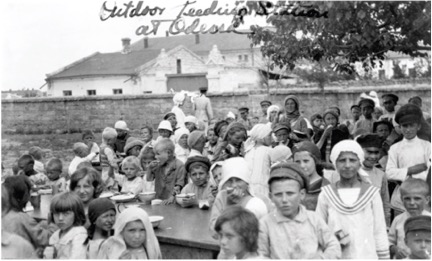Teaching Materials
Suggestions for introducing the teaching of the Holodomor
It is essential that in introducing a topic, students are immediately engaged in searching for an explanation as to why such an event occurred, and are enticed to undergo further study and exploration of various resources to come to their own conclusions. They need to be emotionally involved – it needs to touch their humanity – they need to bring out their feelings and question what happened and why?
Only then does the teaching begin. Most of these suggestions are geared for senior elementary or high school students.
Suggestions for commencing a lesson on the Holodomor with a:
- Picture of the Event (eg. before and after photo)
- Monument
- Brief story
- Quotation
- Related Activity (eg. Bread and Butter)
- Eyewitness account
- Newspaper article
This could be done before an entire class with feedback from students using a brainstorming strategy. The following task may be for individual students or as a group assignment. In that case, the class may be divided into groups, with each group receiving a different item for analysis.
For example:
- By analyzing a photograph, they can deduce what has transpired and then investigate the event about which they gathered information. This is part of the “historian’s craft” as young detectives, they will attempt to understand what happened from the little information they received and therefore, be encouraged to further study the topic.
- By using a quotation of an eyewitness of the time such as a child who remembers a rhyme or a saying of the time.
Eg. “The hammer and sickle – mean death and starvation”
“Wake up Taras, and look around you.
Not a cow or pig in sight, nor a morsel to eat,
Only Stalin’s portrait on the wall.”
N. Mychajlowska, survivor, age 11 in 1933.
- By using a quotation on the consequences of the Famine, e.g. Graciozi
- By showing a portion of a film: eg.newly released Genocide Revealed – Education Version (26 minutes) with focus questions to encourage discussion.
- By showing 11 minutes of Soviet Story – dealing with social engineering and Marxist ideology.
- By watching survivors’ accounts on DVD: who were children in the 1930s in Ukraine. (Question sheet – what did they all say? What occurred? Why did it occur?)
- By examining written eyewitness accounts working in groups, each with a different account, read aloud with discussion questions.
- By reading excerpts from a historical fiction: e.g. The Rings, Maria, Stones Under the Scythe.
- By reading a short story: e.g. “The Rings”, “Without Priests, Without Graves and Crosses”.
- By reading a newspaper article of eg. Holodomor Memorial Day commemoration. What was known? How did the world perceive the Genocidal – Famine?
- By reading a poem, listening to a song: e.g. “Through the Eyes of a Child”, prepared by Halia Dmytryshyn. This poem was written for elementary school students who had painted pictures on the Holodomor.
The short stories may be found on this website.

“Soup Kitchen” Odesa oblast National Museum “Memorial in Commemoration of Famines’ Victims in Ukraine”